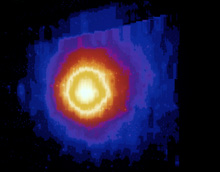Asteroid 2024 YR4 - “The Sky Is Falling - Said Chicken Licken“
https://en.m.wikipedia.org/wiki/Henny_Penny
—
There is a lot of stuff in space and some of it comes our way before we even know it. It’s hard to see what’s catching up to us when you’re looking at the sun so you often see things just after they pass you. That is you hope they passed you and didn’t run into you.
Asteroid 2024 YR4 was identified 2 days after it went by back in December of 2024 and now we think it might, possibly, hit the Moon in December of 2032.
Will you look up and see the fallout?
Mr. k
—
https://spaceweather.com/archive.php?view=1&day=29&month=07&year=2025
ASTEROID STRIKE COULD CAUSE A MOONDUST METEOR STORM: Mark your calendar. If asteroid 2024 YR4 hits the Moon on Dec. 22, 2032, Earth could experience a rare meteor storm made entirely of moondust.
Astronomers at the University of Western Ontario have analyzed what might happen if the 60-meter-wide space rock slams into the lunar surface seven years from now. In a new paper, they report that the impact would release as much energy as 6.5 megatons of TNT, blasting out a kilometer-wide crater and ejecting up to 100 million kilograms of lunar debris.
—
If it does impact the Moon and not us, will there still be stuff hitting Earth?
Read the paper and get a feel for the possibilities.
https://arxiv.org/pdf/2506.11217
The Potential Danger to Satellites due to Ejecta from a 2032 Lunar Impact by Asteroid 2024 YR4
On 2032 December 22 the 60m diameter asteroid 2024 YR4 has a 4% chance of impacting the Moon. Such an impact would release 6.5 MT TNT equivalent energy and produce a∼ 1 km diameter crater. We estimate that up to 108 kg of lunar material could be liberated in such an impact by exceeding lunar escape speed. Depending on the actual impact location on the Moon as much as 10% of this material may accrete to the Earth on timescales of a few days. The lunar ejecta-associated particle fluence at 0.1 - 10 mm sizes could produce upwards of years to of order a decade of equivalent background meteoroid impact exposure to satellites in near-Earth space late in 2032. Our results demonstrate that planetary defense considerations should be more broadly extended to cis-lunar space and not confined solely to near-Earth space.
NASA’s Webb Finds Asteroid 2024 YR4 Is Building-Sized
Editor’s Note: This post highlights data from Webb science in progress, which has not yet been through the peer-review process. These results were reported as part of NASA’s role in the International Asteroid Warning Network.
NASA’s James Webb Space Telescope recently turned its watchful eye toward asteroid 2024 YR4, which we now know poses no significant threat to Earth in 2032 and beyond.
We spoke with Andy Rivkin of the Johns Hopkins University Applied Physics Laboratory, the principal investigator of the Webb Director’s Discretionary Time program used to study the asteroid’s characteristics from the observations.
What is important for people to know about these Webb observations?
While earlier in the year asteroid 2024 YR4 posed a potential future impact threat to Earth in 2032, by the end of February, NASA announced the risk of Earth impact had been significantly lowered to near-zero. Nevertheless, we are interested in using the observatory to measure its properties to understand what asteroids of this size are like to help inform the hazard they could pose to Earth. This is the smallest object targeted by the mission to date, and one of the smallest objects to have its size directly measured.
—
Wikipedia on Asteroid 2024 YR4 has a LOT of information.
You might want to see if you will join the dinosaurs in saying, “What? Again!”
https://en.m.wikipedia.org/wiki/2024_YR4
2024 YR4 is an asteroid with an estimated diameter of 53 to 67 metres (174 to 220 ft)[7] that is classified as an Apollo-type(Earth-crossing) near-Earth object. From 27 January to 20 February 2025, it had an impact rating of 3 on the Torino scale, reflecting its size and an estimated probability greater than 1% that it would impact Earth on 22 December 2032. The estimated impact probability peaked at 3.1% on 18 February 2025. By 23 February, additional observations effectively ruled out 2024 YR4 impacting Earth in 2032 and lowered its Torino rating to 0. Based on all observations up to a James Webb Space Telescope observation on 11 May 2025, there is a roughly 4% chance of impacting the Moon on 22 December 2032 around 15:19 UTC, with the asteroid expected to pass at 9000±74000 km from the surface of the Moon.
The asteroid was discovered by the Chilean station of the Asteroid Terrestrial-impact Last Alert System (ATLAS) at Río Hurtado on 27 December 2024.[1][2]When additional observations increased its impact probability to greater than 1%, the first step in planetary defense responses was triggered, prompting additional data gathering using several major telescopes and leading United Nations–endorsed space agencies to begin planning asteroid threat mitigation.
The asteroid made a close approach to Earth at a distance of 828,800 kilometres (515,000 miles; 2.156 lunar distances) on 25 December 2024, two days before its discovery, and it will be moving away from the Sun until November 2026. Its next close approach will take place on 17 December 2028.[3] Analysis of spectral and photometric time series suggests that 2024 YR4 is a stony S-type (most likely), L-type or K-type asteroid, with a rotation period of approximately 19.5 minutes.[11] A number of known asteroids, including other virtual impactors,[c] follow orbits somewhat consistent with that of 2024 YR4.[17]
—
Thanks for looking up.
Mr. K
==============================
Site: http://lkellogg.vttoth.
BlogSpot: http://
WordPress: http://lrkellogg.
==============================
WHAT THE MIND CAN CONCEIVE, AND BELIEVE, IT WILL ACHIEVE - LRK -
==============================




